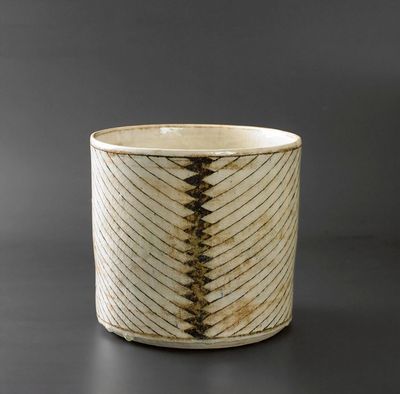User:Shushanik-moutafian
Shushanik-Moutafian
Object from the Boijman
Gertrud Vasegaard,Ronne 1913 - 2007
Kom, 1974
Steengoed, glazuur
Research: Gertrud Vasegaard
Gertrud Vasegaard is the great Danish ceramist of the 20th Century. In Denmark she was recognised again and again and awarded many prizes. Privately she lived a very quiet life, like a Zen-Buddhist, from 1969 alone, together with her daughter the ceramist Myre Vasegaard (1936-2006). Her art, however, was just as generous and subtle as her daily life was austere and modest. Her ceramic work an art pure and strong – equals a level as high as that of Lucie Rie and Hans Coper.
Bowls, vessels and other traditional forms created by Gertrud Vasegaard in stoneware, with such personal integrity and magnetism, make the surrounding rooms vibrate with their own emptiness. Her works just stand there – mild and majestic – with great serenity. But a unique work of Gertrud Vasegaard only reveals its subtle depths slowly. There is a greatness and nobility embedded in the simple, sophisticated, and textural. Form, decoration, body and glaze always unite, giving each piece a silent, warm mental plenitude. No loudness is to be registered, only dynamic rest – like "a Chinese jar still moves perpetually in its stillness" (T.S. Eliot). Each piece stands tangible, down-to-earth, the stoneware mass can be felt in such a way that the textural effect of the material comes into its own. Decorations might look as simple ornaments, engraved, painted, or pressed in contrasting colours, but in fact they are part of her artistic way of celebrating our existence. She was no ceramic rebel; but a master of the craft and an artist who was also a poet. Art is the craft of the mind. The art of Gertrud Vasegaard is obviously connected to the abstract movements of the visual art of the 20th Century, but it is also of a timeless character.
Her works reflect the light, almost dancing with it, but never absorbing it. Gentle tones of grey and white, however the works are never monochrome. Her restricted palette has delicate modulations of umbers, siennas, whites, greens, greys and blues – not unlike the works of the famous Danish painter Vilhelm Hammershøi. Gertrud Vasegaard wanted light to reflect an openness and spiritual feeling of benevolence. Technically, she achieved triumphs in making lightly crackled glaze that shine – almost like the famous “Ru ware” from the Northern Song Dynasty made between the years 1086-1106.
Her use of lines is special too. The visual movement is upwards. Abstract triangles, quadrangles, spirals, stripes, and rectangles are seen on her forms in perfect harmony. She actually has made the use of the line a speciality in Danish ceramics, using the line as controlled energy and a formative element in the individual work. Form and decoration melting together in a unique way. Lines bring elements together: base and top, the movement of the eye and the three-dimensional form. The "kumme" form has been one of her most innovative ceramic cylinder forms with upward moving lines – giving a stronger sense the "turning" of the cylinder. However, they are also part of a story of well organized "dividual" lines. Giving a spiritual expression to each piece of work, dividual and individual elements, are interconnected in a way that recalls the work of Paul Klee.
